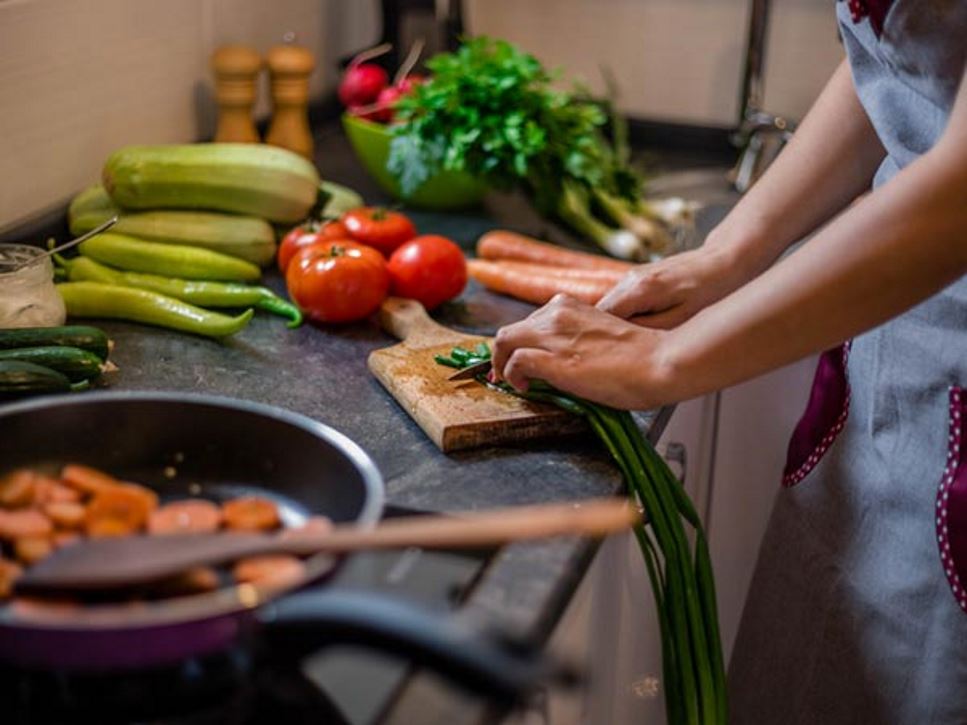Braise, broil, poach, simmer — what does it all mean? Following healthful recipes is easier if you understand cooking vocabulary. Whether you are new to the kitchen or just need a refresher, understanding the basics of common cooking techniques will help you navigate through recipes and get healthy meals on the table with ease. From slicing to steaming, here's how to talk the talk in the kitchen.
The B, C, and Ds of Cooking
- Bake: type of dry heat cooking —food is cooked using the hot air surrounding it, usually in an oven
- Barbecue (grill): type of dry heat cooking — to roast or broil food over a source of heat like charcoal or hardwood fire
- Boil: type of moist heat cooking — a liquid is brought to a boil and food is cooked in it
- Braise:to brown, then simmer slowly over low heat in a small amount of liquid in a covered pot, on the stove or in the oven
- Broil:to cook using a direct heat source, usually under a heating element in the oven, but it can also be done over a flame of a grill
- Chop: cut food into smaller pieces of no particular size or shape
- Dice: cut foods into uniform square pieces
- Deep-fry: type of dry heat cooking — cook food by submerging it in hot oil
- Dry heat cooking: methods that use hot air, the heat from a pan or grill, or hot fat to cook foods.
From G to Ps & Qs
- Grate: to create small (fine or coarsely shredded) pieces by rubbing food against a serrated surface
- Mince: cut food into very small pieces
- Moist heat cooking: methods that use water or liquids such as broth to cook foods
- Panbroil: to cook uncovered in a preheated, skillet without added fat or water
- Poach: type of moist heat cooking — to cook gently in simmering liquid
- Quadriller: to make a crisscross pattern on the outside of grilled or broiled food
R to Z
- Roast: type of dry heat cooking — to cook uncovered with dry heat in the oven or in a fire
- Sauté: type of dry heat cooking — to cook quickly in a small amount of fat
- Simmer: type of moist heat cooking — cooking food in a hot liquid that is bubbling but not boiling
- Slice: to cut through or across into slices, generally of uniform size
- Steam: type of moist heat cooking — to cook a food over boiling water with the steam heat, or wrapped in foil or leaf (such as banana leaves) packets over boiling water or on a grill
- Stew:to cook in a liquid, in a tightly covered pot over low heat
- Stir-fry: to cook small pieces of food over high heat, stirring continuously – generally with only a small amount of oil
- Zest: to scrape the outer rind of a piece of citrus fruit for flavoring
Be in the Know
Knowing these culinary techniques can help to bring out the flavor of foods without the need to add a lot of extra ingredients or calories. The healthiest cooking methods require only a little amount of fat:
- Sautéing and stir-frying use a small amount of oil, compared with frying or deep-frying.
- Steaming helps foods retain more nutrients, since they are not soaking in water, as is the case with boiling.
- Grilling also can influence the flavor of foods, but it's important to avoid charring them, which occurs when they turn black.
- Marinating meats and vegetables prior to grilling can help add flavor and keep them moist.
And, remember that cooking all foods to the appropriate internal temperatures is important, regardless of how the food is prepared!
Find a Nutrition Expert
Looking for credible nutrition information and recommendations? The Academy of Nutrition and Dietetics' network of credentialed food and nutrition practitioners are ready to help!
